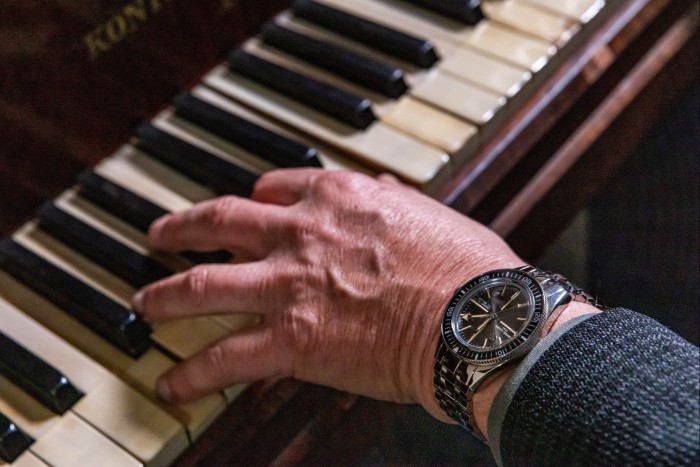Favre Leuba looks to Indian links to revive its fortunes

It hasn’t sold a watch yet but, according to its chief executive Patrik Hoffmann, the newly relaunched Swiss watch company Favre Leuba will be shifting 100,000 pieces a year in as little as a decade.
Favre Leuba was founded in 1737. However, when it was sold by the eighth generation of its founding family in 1985, it all but disappeared. It is thought it passed between five different owners, including the French luxury group LVMH and Titan, part of India’s Tata Group. Despite the mechanical watch boom over the past couple of decades, none was able to revive it.
Then, last year, it was bought from Titan for a reported SFr1.49mn ($1.76mn) by Silvercity Brands, a subsidiary of the Indian conglomerate KDDL. Hoffmann was appointed and, at Geneva Watch Days in August, he whipped the covers off 22 new Favre Leuba references inspired by “air, land and sea” that will retail for under SFr5,000.
By Hoffmann’s admission, the timing of the launch could have been better. Data from the Federation of the Swiss Watch Industry shows that, in August, export values (roughly half retail) of watches priced at less than SFr3,000 shrank by 14.4 per cent by value and 11.3 per cent by volume. “It’s not an easy part of the market,” he admits.
But Hoffmann, a former chief executive of high-end Swiss watchmaker Ulysse Nardin, believes market shifts over the past decade have created an opportunity. “Certain reputable brands have moved out [of this segment] in terms of pricing and we have positioned ourselves there,” says the 59-year-old Swiss. “The global potential is in the niche where we are.”
He has a point. Generalist brands such as Omega, Breitling and Tag Heuer have climbed into the SFr5,000-SFr10,000 price segment in recent years, leaving Favre Leuba looking to take market share from brands such as Longines, Rado, Oris, and UK company Bremont. “We don’t see ourselves as a microbrand,” says Hoffmann. “We see ourselves as a volume brand. It’s not good to be isolated.”

Favre Leuba’s new collection will start at SFr2,200 for the time-and-date-only Deep Blue, and top out at SFr4,375 for the Chief Chronograph. In between is the SFr3,950 Sea Sky, a chronograph inspired by a vintage Favre Leuba dive watch that Hoffmann believes captures current trends.
“Today’s consumer is looking back into the past,” he says. “What we launched at Geneva Watch Days proved we are right-on, in terms of product.”
Industry experts think Hoffmann has a mountain to climb. Oliver Müller, founder of Swiss consultancy LuxeConsult and co-author of Morgan Stanley’s annual watch industry report, describes the plan to revive the brand as “ambitious”.
“Restarting a historic brand from scratch as a generalist brand, in the chosen price range, is challenging,” Müller suggests. “The stop and go of a brand, with successive aborted relaunches, is never a good sign for the trade — or end-customers.”
Hoffmann, who is also a former executive vice-president of pre-owned watch specialist WatchBox (now The 1916 Company), says it took just 10 months to take his new collection from concept to launch, and that he has 4,000 watches in production, a figure he expects to double in 2025.
Ironically, he reckons it is the current climate that has made progress possible. “What’s really helped is the downturn that’s happening right now,” he says. “It was easier to open doors.” Typically, new lines can take years to develop, but Hoffmann says suppliers have been quick to respond as established brands cancelled orders and furloughed workers in a bid to avoid overproduction and a flow of surplus watches on to the grey market.


Hoffmann says Favre Leuba will manage assembly in the future but, for now, is working with La Joux-Perret for movements and Swiss private-label companies Roventa-Henex and Fabhor for sourcing components, such as cases and dials, and assembling the watches. It also outsourced the design of its launch collection, but intends to bring this in house, too.
The brand’s chances of success may yet be dependent on the Indian market. KDDL holds a majority shareholding in Ethos, India’s largest multi-brand luxury watch retailer, and owns Estima, a Swiss company based in Grenchen, where it produces watch hands. Favre Leuba is in the process of setting up its operation, including a museum that will house 125 historic pieces, on Estima’s premises.
“We have a big advantage that the brand is already very well established there,” Hoffmann says of India, drawing attention to Favre Leuba’s claim that it was the first Swiss watch company to enter the country in 1865. “And we have a good partner in Ethos.”
Hoffmann also believes India’s promise as a fertile ground for luxury brands is starting to bear fruit. Rado, another mid-market Swiss watchmaker, is already well established there, and exports of Swiss watches to the country increased 74.9 per cent by value between 2022 and 2024 according to the FHS — a period of record revenues for the industry.
Some experts think there may be more to come. “A new free trade agreement between Switzerland and India could accelerate growth in the coming years,” says Rob Corder, editor-in-chief of specialist title WatchPro, referring to the European Free Trade Association’s deal with India in March. “Correct positioning in India could give Favre Leuba an instant leg-up.”
But Müller says that will attract competition from brands with higher profiles and bigger budgets. “India is the new phantasm of almost every watch brand chief executive as the new China,” he says, pointing to continued flagging exports to China and Hong Kong.
“Favre Leuba has very strong links with the country, but the question will be how much it can rely on leveraging that legacy with a younger demographic, who might be less inclined to historical ties than brand recognition.”
What makes Hoffmann think the brand will fly this time? “The previous owners searched for the right way and they just didn’t get it,” he says of Titan, adding that it had focused on large-scale instrument watches at a time when watches were getting smaller.
And LVMH? “Their heart wasn’t in it,” he concludes. “But we’ve had a good start. If we continue to bring a good value proposition and the design is right, we will be successful.”
#Favre #Leuba #Indian #links #revive #fortunes






